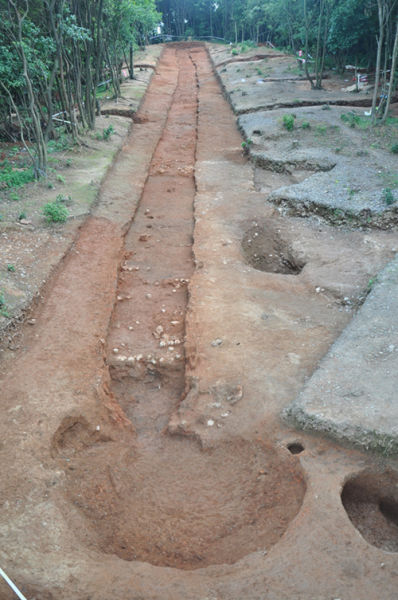(单词翻译:单击)
听力文本
This is News Plus Special English. I'm Marc Cavigli in Beijing.
Archaeologists in north China's Shanxi Province have discovered a 1,400-year-old temple where a collection of statues of the Buddha were stored.
The shrine, enclosed by walls carved with Buddha niches, is part of the Tong-zi Temple complex secluded on a mountain near the city of Tai-yuan, the provincial capital.
The structure was built in the Northern Qi Dynasty which was a booming period for Buddhism in China.
Researchers from the Chinese Academy of Social Sciences says the structure is the only one of its kind ever found in China and it sheds light on early Buddha carvings.
The temple remains almost intact. One of the walls has a carving of a Buddha which is over 20 meters high.
There is also a 2.6-meter tall mural which was built in the Tang Dynasty more than 1,000 years ago. It is one of the oldest murals found in the region.
Another piece of news about archeological findings in China.?
Archaeologists have discovered an ancient kiln of over 1,200 years old in Jing-de-zhen, China's porcelain capital, located in eastern China.
Jing-de-zhen has been a traditional porcelain production center since ancient times.
The kiln is also called a dragon kiln. It is a long, sloping chamber, with a firebox at one end and a flue at the other. The 80-meter long kiln is the biggest ever found that was built in the Tang Dynasty.
The dragon kiln is located in the ruins of Nan-yao Village. Tons of ceramic tools and fragments were also found at the ruins which cover around 1,000 square meters.
The ruins were first discovered in 1964. But it was left without further excavation because of the poor preservation conditions for unearthed relics back then.
In recent years, as debates heat up for when precisely Jing-de-zhen started its porcelain production, archeologists began to dig and study the Nan-yao ruins.

中文翻译
这里是NEWS Plus慢速英语。马克·卡维格里从北京为您播报新闻。
考古学家在中国北部省份山西省发现了一座有1400年历史的古寺,寺庙内供奉着佛像。
这座墙壁上雕刻着佛龛的寺庙是童子寺庙建筑群的一部分,独自坐落在山西省会太原市附近的一座山上。
这座寺庙建于北齐时代,当时正是佛教在中国的盛行期。
中国社会科学院的研究人员表示,中国发现的这一建筑是独一无二的,使人们对早期佛教雕刻有了进一步的了解。
这座寺庙几乎完好无损。其中一面墙上雕刻的佛像超过20米高。
寺庙内还有2.6米高的壁画,壁画绘于唐代,有超过1000年的历史。这是在该地区发现的最古老的壁画之一。
再来看另一则中国的考古发现。
考古学家在中国景德镇发现了有1200年历史的古窑,景德镇是中国的瓷都,位于中国东部。
从古代开始,景德镇就是传统的瓷器生产中心。
这座古窑又称为龙窑。窑室呈长条状,一端是燃烧室,另一端则是烟道。这座古窑长80米,是迄今为止考古揭露的最长唐代龙窑遗迹。
这座龙窑位于南窑村遗址。该遗址揭露面积超过1000平方米,同时出土数吨窑具和瓷片标本。
遗址最早于1964年被发现。但是由于当时出土文物的保护条件有限,所以未能展开进一步挖掘工作。
近年来有关景德镇是何时开始瓷器生产的讨论日益热烈,考古学家也开始了对南窑遗址的挖掘和研究。
译文属可可英语原创,未经允许,不得转载
重点讲解
重点讲解:
1. shed light on
使(某事)显得非常清楚;使人了解(某事);
eg. She has told them nothing that could shed light on her husband's whereabouts.
她没向他们提供任何有关她丈夫下落的线索。
eg. This information may shed light on me mystery.
这项情报可能有助于查明那件疑案。
2. because of
因为;由于;
eg. Many institutions exchange information by hand because of incompatible computer systems.
由于计算机系统不兼容,许多机构通过人工方式进行信息交换。
eg. The match is off because of a waterlogged pitch.
由于场地积水太多比赛被取消了。
3. heat up
激化;加剧;变得激烈(或热烈);
eg. The election contest is heating up.
选举竞争正趋于白热化。
eg. That change heated up inflation.
那一变化加剧了通货膨胀。


